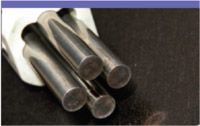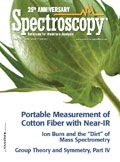Ion Burn and the Dirt of Mass Spectrometry
Ken Busch explores the dirt of mass spectrometry ? its origins and its visible consequences in a deposit on metal surfaces called ion burn.

We usually think of the inside of a mass spectrometer as a "clean" environment. In interpretation of electron ionization (EI) mass spectra, we attempt to deduce rational unimolecular dissociations of ions that can be related to structure. These dissociations occur in the gas phase, isolated from the physical components of the mass spectrometer. In chemical ionization mass spectrometry (MS), controlled ion–molecule reactions occur. Again, these gas-phase reactions do not involve the surfaces of the mass spectrometer. Although heated metal surfaces can catalyze or initiate certain reactions, instruments are constructed and designed to minimize chances for such usually deleterious reactions. But these reactions can and do occur, and we do have to keep in mind the possible effects of the instrument surfaces on the quality of the measurement. Often, before considering surface-related reactions, we must confront the simple fact that the mass spectrometer gets dirty and that this dirt has an effect on instrument performance. In post-use examination of the instrument, surfaces within the ionization source and the surfaces of the mass analyzer, we find the dirt that forces us to agree that "clean" is a relative term. There are two sources of contamination within a mass spectrometer in normal operation. One source is material introduced into the instrument as sample (concentrated in the ion source), and the second source is backstreamed material from the vacuum pumps, which pervades the entire system. Both sources of contamination make the mass spectrometer a dirty place.
Instrument operators become well aware of consequences of mass spectrometric dirt, and ionization source cleaning is periodic maintenance. When an ionization source gets dirty, observed instrument sensitivity usually decreases and focusing potentials change or become unstable. The presence of an organic layer (which can be insulating) on a metal lens surface changes the field gradient created by a focusing lens. In an EI source, the dirtiness of the source is often visually apparent upon disassembly and inspection. The filament reflector is often discolored, with a darkish, sometimes iridescent, smudge on the metal surface; this is called ion burn. The ion exit holes also are usually surrounded with a darker ion burn. This burn can build up to the point at which material actually flakes off the metal surface, confirming that the burn comes from material deposited on the surface (probably from the sample) and is not instead the result of simple heat discoloration. It is often thought that this source ion burn is the result of high-temperature oxidation of organic compounds introduced into the source. The volatilized organic compounds decompose into less volatile compounds that deposit on the source walls, although the source is usually heated to minimize adsorption. If thermal decomposition was the only process occurring, then the deposition would be uniform around the source. However, within the ionization source there is an electron beam emanating from the filament, and a more diffuse and less intense beam of ions directed to the exit slit (as well as any ions of the other polarity heading in the opposite direction). Electron- and ion-induced reactions in the gas phase can lead to sample decomposition. Of probably greater importance are reactions induced by the continual low-energy electron and ion bombardment and sputtering of organic adsorbates on the source surfaces, leading to polymerization. In the usual mode of operation of an EI source, positive ion bombardment will be concentrated at the ion exit aperture, and negative ions (not formed in equal intensity) impact the nearest positively biased surface. The observed ion burn is the end result of all of these simultaneous reactions. An analogous ion burn often is observed at the edges of lens elements or beam-defining slits adjacent to the source. These surfaces also must be cleaned regularly.
Given the complexity of ion sources and the many different materials used in their construction, ion source cleaning is a matter of some experience, some art, and a great variety in recommended procedures. A good start can be found in articles prepared by Scientific Instrument Services (1), and, of course, more specific instructions from the instrument manufacturer. The discussion here has concentrated on EI and chemical ionization sources. Other sources also need regular maintenance, although the source of "dirt" might be different. In electrospray ionization (ESI) sources, filtering of solvents is especially important, and flow through the spray needle should be continuous to avoid the formation of precipitates in the sprayed solution within the needle. In ESI sources interfaced with trap mass analyzers, blocking the source when ions were not allowed into the trapping cell reduces the need for source cleaning (2), and off-axis spray geometries are thought to minimize blockages and fouling of ion entrance apertures.
As described earlier, one source of the dirt that results in ion burn is the sample itself, along with carrier gases and solvents. Only a small fraction of the sample is ionized. Most of the sample is pumped away as neutral gas molecules and is transported through the high-vacuum pumps to the rough (backing) pumps. The rough pump oil eventually becomes an integrated repository for samples, serving as a holding reservoir for entrapped organic compounds, which might eventually diffuse into the exhaust stream. Rough pump oil eventually degrades with use and must be replaced; it should rightfully be considered hazardous waste. It informs our discussion of the "dirt" of MS to consider the fate of the nonionized fraction of sample. Step back to follow the route of sample introduced into a gas chromatography–mass spectrometry (GC–MS) system. Sample molecules enter a heated injection port where they are volatilized, and are then transported in a stream of carrier gas through the heated column, remaining in the gas phase as they move through the column. These sample molecules pass through a heated postcolumn interface region into a heated ionization source, hopefully remaining still in the gas phase. Those molecules that are ionized are accelerated out of the source into the mass analyzer. The majority of molecules that are not ionized are pumped out of the source into an expansive volume enclosed by surfaces that are no longer heated. The opportunity for condensation and adsorption on the postsource surfaces is high. Contamination of these surfaces and this part of the pumping system usually does not significantly impact instrument performance, but the distribution of this "dirt" should be understood in a practical sense. The source rough (backing) pump often needs more regular maintenance than do the other backing pumps, and its exhaust should certainly be filtered and directed to a fume hood.
Our attention now turns to the sample molecules that are ionized. In a through-space instrument, these ions travel from the source through the mass analyzer, eventually to be destroyed (and converted to an electrical signal) at the detector, whether it is an electron multiplier, a photomultiplier, or some other transducer. At each stage in transit through the instrument, various losses deplete the ion current. When the "lost" ions encounter a surface (such as the inner surface of a flight tube or a quadrupole rod), they are neutralized. They can become gas that is pumped away immediately, or they can be deposited as part of the adsorbed organic film on that surface. In the analysis of radioactive samples, it can be shown that eventually all inner surfaces of the mass spectrometer become coated with radioactive residue. A unique procedure to reduce the background signal obtained by radioactive ions implanted into the first dynode of the electron multiplier has been described (3). It is of interest here that the sample in one instance becomes contamination in the next. The take-home lesson is that sample ions, in time, become distributed throughout the entire instrument.
Consider, in a very broad sense, production of ions in the ionization source. A general goal is that all ions produced in the source are accelerated into the mass analyzer. This population of ions might contain many ions outside the mass range scanned by the analyzer. For example, many scans have a lower mass limit of 50 so that intense ions at m/z 28, 32, 40, and 44 (background ions from residual air) or ions representative of a chemical ionization reagent gas are not recorded in each mass spectrum. The contribution of these ions to the total ion current from the source can be substantial and far more intense than ions derived from any sample. We don't usually consider such ions as dirt or contamination, and often, we don't even consider them at all. However, they do contribute to sputtering and polymerization processes of adsorbates on metal surfaces, even though they might not directly be a source of residue on those surfaces.
We'll next trace the paths of ions that pass into the mass analyzer through a quadrupole mass filter and the sector mass analyzer. Principles of operation for the quadrupole mass filter are described in introductory texts (4). The quadrupole mass filter operates by creating electric fields such that, at any given instant (and set of electric fields), ions of only one mass follow a stable trajectory through the entire length of the rod assembly. Other ions of different masses follow unstable trajectories, meaning that they exit the rod assembly, or more likely, collide with one of the rods. Most of those collisions occur near the source end of the rod structure, and it is here that ion burn is often observed (Figure 1). In the past, the shape of these burns and their symmetry have been linked to the profile of the ion beam and the process of its mass analysis. But the observed ion burn is the result of millions of ion collisions, subsequent sputtering processes, and so many other convolved reactions that it is best not to over-interpret the pattern. A consequence of ion burn on the quadrupole rods is sometimes seen in the shape for an ion beam, appearing as a lift off on one side of the peak. The ion burn is often semi-insulating and changes the symmetry of the electric fields otherwise generated by the rods. As noted earlier, the ion burn can be formed primarily by intense ions outside the scanned mass range. But it should also be remembered that the quadrupole mass filter operates by passing through to the detector only one mass ion at any instant. All of the other ions from the sample follow unstable trajectories. At any instant during a scan across the mass range, the device is discarding most of the ions derived from the sample. Certainly, in a selected-ion monitoring experiment, only the selected ions pass through to the structure, all other ions of other masses are discarded. It should come as no surprise that the rods become dirty and that a visible ion burn results. Although some part of the ion burn derives from sample ions, it is also partly the result of ion bombardment of contaminant material adsorbed onto the quadrupole rod, as discussed later.

Figure 1: Ion burn on the front end of quadrupole rods. The burn usually appears on all four rods, but it may not be symmetric. The size and shape of the ion burns should not be over-interpreted.
In a sector-based mass spectrometer, the (usual) scan of the magnetic field strength means that, at any given instant, only ions of one particular mass are making it through to the detector. Ions of other masses will collide with the inner surfaces of the flight tube. But their distribution is spread over a much greater surface area than in the quadrupole mass filter, and so a distinct "ion burn" is not usually seen on these surfaces. Should one disassemble a sector mass spectrometer and swab the inner surfaces of the flight tube, some visible residue usually can be seen. But this is not dirt of the same sort as an ion burn. Given the pressures at which most mass spectrometers operate, the interior surfaces of the instrument itself are covered by layers of adsorbed gases and system contaminants. The adsorption and desorption of gases on metal surfaces as a function of temperature and pressure are well-studied phenomena. Surface science research on clean surfaces (such as with secondary ion mass spectrometry) usually involves operation at 10-9 Torr and below. The 10-6 Torr pressure of the ordinary organic mass spectrometer seems, by comparison, to be an organic soup. The old saying, "One scientist's vacuum is another one's sewer," although meant to be humorous, is not inaccurate. We'll use the general term "contaminant" for any of the many organic adsorbates that can be found on an otherwise "clean" metal surface inside a mass spectrometer.
The major source of this adsorbate contamination within a mass spectrometer derives from the pumping system (5). Backstreamed oil from diffusion pumps, turbomolecular pumps, and transfer of lubricants from other moving parts within the system will inevitably find their way into the main vacuum chamber and distribute throughout the system. Vacuum system devices designed to decrease the flux of backstreamed vapors include baffles and cold traps, and the importance of proper operation in bringing a system to atmospheric pressure and pumping it down afterwards must be foremost. Considering that some degree of contamination is inevitable, many instruments, including larger sector instruments, include provisions for a bakeout. In the bakeout process, the instrument is jacketed in an insulating cover and the internal metal surfaces are heated to a high temperature while still under vacuum to force desorption of adsorbates. It is especially important to heat the instrument uniformly, as any desorbed gases will find a cold spot in the system and condense upon it. Vacuum science provides sophisticated tools assembled into a balanced system, all with the same goal of moving gas molecules from inside the vacuum chamber to the outside world. But realistic vacuum science deals with leaks, and these occur at every flange and every feedthrough. Lower and lower ultimate pressures are achieved within the system when the pumping speed exceeds the flow rate of leaks into the system. But even pressures that appear to be steady represent a dynamic equilibrium, and the presence of contaminants in the system, including the samples themselves, is a given. Sensitive as the instrument might be, the mass spectrometer is a dirty environment indeed.
Ions that do transit the entire mass spectrometer finally reach the detector. In the dynode electron multiplier detector, the high-velocity impact of a positive ion at the entrance dynode of the multiplier releases electrons that are accelerated to the next dynode, releasing still more electrons in a cascading process. In much the same manner that ion burn can appear elsewhere in the mass spectrometer, the electron multiplier itself can be contaminated, and processes have therefore been devised to clean and rejuvenate such devices. Many modern instruments use a phosphor and photomultiplier tube combination as a detector, because this arrangement can be less susceptible to decreased performance due to contamination.
On a final note, "ion burn" is also a technical term used to describe the visible spot on a cathode ray tube, as used in an old television or scope, representing damage to the coated layer. An authoritative review of this phenomenon by Sloane and Watt in 1948 (6) is especially interesting in that it describes the extensive use of MS to attempt to identify the positive and negative ions thought to be present in the system.
Kenneth L. Busch thanks Jonathan Batey and Bob Bateman for discussions of the phenomenon of ion burn. He is amused that a web search for "ion burn" leads to many sites that describe a phenomenon observed in older cathode ray tubes such as those used in the early days of television. Because many of those web sites are presented in a historical sense ("this technology is SO old!"), he is not quite so amused that he remembers such TV ion burns from first-hand experience. This column is the sole responsibility of the author, who can be reached at WyvernAssoc@yahoo.com.

Kenneth L. Busch
References
(1) For example, http://www.sisweb.com/news/sep2003.pdf.
(2) SA. Hofstadler, K.A. Sannes-Lowery, and R.H. Griffey, Rapid. Commun. Mass Spectrom. 13(20), 1971–1979 (1999).
(3) F. Touchard, G. Huber, R. Fergeau, C. Thibault, and R. Klapisch, Nucl. Instrum. Meth. 155(2), 449–451 (1978).
(4) P.H. Dawson, Quadrupole Mass Spectrometry and Its Applications (Elsevier, New York, 1976).
(5) http://www.vacuumlab.com/Articles/Oil-Sealed%20Pumps%20and%20Backstreaming.pdf
(6) R.H. Sloane and C.S. Watt, Proc. Phys. Soc. 61, 217–234 (1948).

Best of the Week: Hawaiian Geology, Meteorite Clues, Cat Food
May 30th 2025Top articles published this week include an interview with Pooja Sheevam about her study analyzing Hawaii’s PTA-2 drill core, several news stories on recent meteorite studies, and a news article on using Raman spectroscopy and artificial intelligence (AI) to detect adulteration in maple syrup.

.png&w=3840&q=75)

.png&w=3840&q=75)



.png&w=3840&q=75)



.png&w=3840&q=75)














